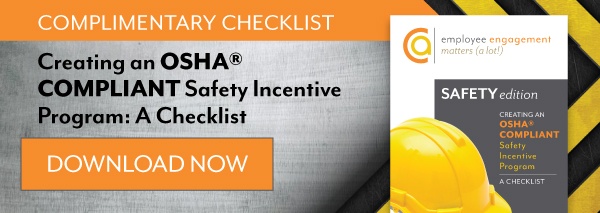Editor's Note: This article was originally published on August 06, 2014 and has been recently updated.
Do Behavior-Based Safety Incentive Programs Work?

When aiming to build a workplace focused on employee safety, there are often some misconceptions behind behavior-based incentives and reward programs. Some safety professionals believe that behavior-based safety incentive programs somehow take the responsibility away from management, leaving it solely on the employee, or that behavior-based programs somehow blame the employee for an unsafe work environment. In order to implement a successful safety incentive program, managers and employers must buy in fully into the program, while empowering employees to make safe decisions for themselves and their coworkers.
Why Are Behavior-Based Safety Incentive Programs Important?
Behavior-based safety incentive programs are designed to influence employee actions and ideally prevent an accident or injury before it occurs. When implemented correctly, these safety programs can help to reduce unsafe behavior, minimize lost production hours, and improve overall workplace morale. Often accidents occur due to unsafe acts, rather than unsafe conditions. By implementing a behavior-based program, you can enforce solid principles focused on reinforcing and sustaining safe acts or behaviors.
How to Have a Successful Behavior-Based Safety Incentive Programs
In order to achieve noticeable and lasting results, your program must work to involve employees at every level, along with emphasizing strong communication and open feedback. The following are requirements highlighted by the Health and Safety Administrative to achieving a successful safety program:
- Strong commitment from management to maintain and improve behavioral safety. Change often starts from the top, if this commitment is showcased in daily acts and processes, the behavior will often trickle down to staff members.
- Respectful, trusting, and open communication between management and employee groups. Having a feedback-rich culture allows employees to learn and grow, while maintaining conversations about all aspects of safety in the workplace.
- A commitment to improving overall feelings and attitudes to workplace safety and health, as well as increasing employee engagement in safety.
- Emphasizing the differences between safe and unsafe behaviors, rather than focusing alone on lagging indicators such as safety statistics.
- Strong, consistent, and timely reactions to the discovery of unsafe actions, whether they result in injury or not. Safety incidents should be viewed as an opportunity to learn and improve and should never be hidden to avoid losing an incentive.
- Transparent and fair leadership from all, including managers, supervisors, and owners.
- Awareness amongst staff of the different ways we do things and how we can improve internal processes.
Our Responsibility is Workplace Safety
As safety professionals, it is our responsibility to ensure that our employees' work environment is as safe as it can be, that they have the proper PPE, and that the equipment works properly. But the reality of it is, we can’t be everywhere at once, and we have to rely on our employees to observe and report any unsafe conditions that may have been mistakenly overlooked.
When you incorporate a behavior-based safety incentive program, you are not limited to reporting near-misses and wearing PPE. They are the holistic approach to maintaining safety awareness in the workplace. These types of safety programs are about rewarding employees that participate in raising awareness through training, suggestions, and prevention. Behavior-based safety incentive programs aren’t about identifying unsafe behavior and punishing those responsible, but about identifying unsafe conditions and rewarding those that help prevent an injury from occurring in the first place.
The bottom-line: Employees shouldn’t be blamed for being put into an unhealthy and unsafe environment, and they shouldn’t be punished for reporting unsafe behavior. By partnering with C.A. Short Company, we can help you create a custom safety incentive program tailored to helping you establish a well-rounded company culture of safety. Our Safegagement™ platform can help you analyze and measure both leading (behavior-based) and lagging (incident-based) indicators, while enabling you to easily connect your workforce and modify behaviors. Sign up for a complimentary consultation to learn more today!
At C.A. Short Company, we are your partner for increased employee engagement resulting in increased performance outcomes to grow your bottom line. Our process and research-based platform helps you engage your team in order to increase your bottom line, motivate your staff to the benefit of the entire organization, and reward your people for the positive changes they make. To request a Complimentary Consultation,
please click here.
